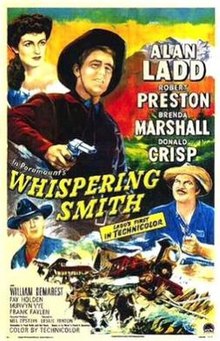|
Whispering Smith
Whispering Smith is a 1948 American Western film directed by Leslie Fenton and starring Alan Ladd as a railroad detective assigned to stop a gang of train robbers. The supporting cast includes Robert Preston, Brenda Marshall and Donald Crisp. The picture is based on a novel by Frank H. Spearman and a previous 1926 film adaptation starring H.B. Warner. PlotThe bad Barton boys—Blake, Leroy and Gabby—rob a train and shoot a guard. Luke Smith, known as "Whispering" to some for his quiet ways, is a detective for the railroad sent to investigate. Murray Sinclair, an old friend of Smith's, is in charge of the railroad's wrecking crew. He's glad to see Smith, who shoots Leroy and Gabby and is saved when a bullet is deflected by a harmonica in his pocket, given him long ago by his sweetheart Marian, who is now Sinclair's wife. It saddens Smith to find out that Sinclair might be in cahoots with Barney Rebstock, a rancher with a bad reputation. Rebstock has been hiding the remaining Barton brother, Blake, who is tracked down by Smith. Whitey DuSang is a hired gun for Rebstock, who wants to see Smith dead. When the railroad's boss gives Sinclair an order, Sinclair rebels and is fired. Rebstock hires him to pull off a string of daring train holdups. Smith forms a posse. Whitey kills a guard and betrays Rebstock, shooting him. Sinclair is wounded. Smith does away with Whitey but gives his old friend Sinclair a last chance. When Sinclair rides home, he finds Marian packing and strikes her, accusing her of leaving him for Smith. Smith shows up and Sinclair apologises for his actions. He seems sincere, but when Smith's back is turned, Sinclair pulls a hidden gun. Before he can fire, Sinclair falls over and dies from his wound. Smith leaves town, his work there done. Cast
ProductionThe film was announced in early 1947 as a vehicle for Alan Ladd.[3] It was Ladd's first Western and his first movie in colour.[4][5] The script made a number of changes to the original novel including changing the double love story to one.[6] Brenda Marshall was given her first screen role in four years. Filming began on 14 April 1947.[7] The role of Whispering Smith was partly based on Jake Lefors. The part of Murray Sinclair, Smith's friend who turns to crime, was supposedly inspired by Butch Cassidy.[8] The filmmakers built a Western town on five acres (2.02 ha) of the backlot at a cost of $70,000.[9][10] It included 2,000 feet (609.6 m) of railroad track, on which authentic 1870 locomotives owned by Paramount were operated. The trains were converted from their original wood-burning fuel system to oil by their original owner, the Virginia & Truckee Railroad of Carson City, Nevada. The set was later re-used in many later TV shows and films, including Bonanza.[8] ReceptionThe film was not released until 1949, by which time Paramount had made and released another Ladd film, Beyond Glory. The film was popular with audiences. According to Variety it was the 20th-most popular film in the US and Canada in 1949.[11] It was also one of the most watched films of the year in the UK.[12] Possible follow-upSol Lesser, who had rights to ten Whispering Smith stories, wanted to film some of them with Robert Mitchum,[13] who had begun his career as a leading man in a pair of Zane Grey Westerns. These films were not made. However, Audie Murphy later starred in a Whispering Smith TV series. References
External links |
||||||||||||||||||||||||||||||||||||||
